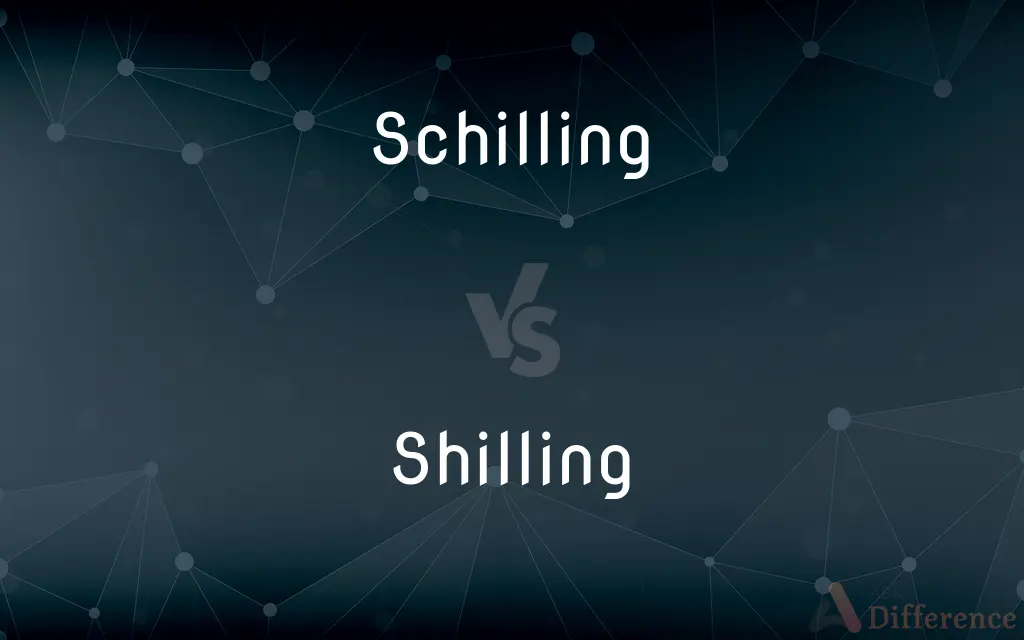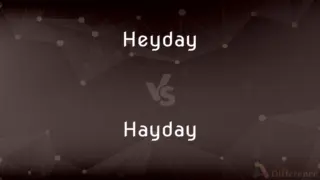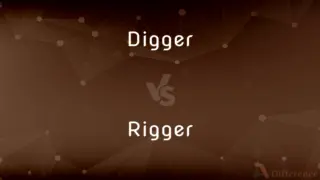Schilling vs. Shilling — What's the Difference?
By Urooj Arif & Fiza Rafique — Updated on April 4, 2024
Schilling refers to the former currency of Austria, discontinued in 2002, while a shilling is a historical unit of currency in various countries, notably the UK.

Difference Between Schilling and Shilling
Table of Contents
ADVERTISEMENT
Key Differences
Schilling was the official currency of Austria until it was replaced by the euro in 2002, serving as a fundamental monetary unit for the nation's economy. On the other hand, the shilling has been a unit of currency in several countries, including the UK until 1971, and continues to be used in some African nations, reflecting its broader historical and geographical usage.
The schilling was introduced in Austria in 1924, stabilizing the economy after the first World War and the inflation period that followed. Whereas the shilling has a longer history, first established in England in the 16th century, indicating its deep roots in financial systems of the past.
Schillings were subdivided into 100 groschen, a system that facilitated detailed financial transactions and budgeting within Austria. Conversely, the shilling was traditionally divided into 12 pence in the UK, demonstrating a different approach to currency subdivision which impacts financial calculations and transactions.
With the transition to the euro, the schilling ceased to be legal tender, marking a significant shift in Austria's economic identity. On the other hand, the shilling's transition varied by country, with the UK moving to a decimal system in 1971, but it remains in circulation in some countries, showing a diverse impact on national currencies.
The exchange rate of the schilling to the euro was fixed at 13.7603, a critical piece of information for financial history and transactions involving old currencies. In contrast, shilling values vary significantly across different countries and time periods, complicating historical and international financial comparisons.
ADVERTISEMENT
Comparison Chart
Introduction Year
1924 (Austria)
16th century (England)
Countries of Use
Austria
UK, various African countries
Subdivision
100 groschen
12 pence (UK), varies in other countries
Replaced by
Euro in 2002
Decimal currency in UK, varies elsewhere
Historical Context
Stabilized Austria's post-WWI economy
Long-standing currency in British territories
Compare with Definitions
Schilling
The schilling was the currency of Austria until 2002.
In 2001, a loaf of bread cost about 20 schillings in Vienna.
Shilling
It is still used in some African countries as currency.
In Kenya, 100 shillings roughly equal one US dollar.
Schilling
Collectors often seek schilling coins for their numismatic value.
He added a 1952 2-schilling coin to his collection.
Shilling
The shilling was traditionally divided into 12 pence.
She paid six pence, half a shilling, for a cup of tea.
Schilling
It was subdivided into 100 groschen.
He found a 50 groschen coin, half the value of a schilling.
Shilling
Some countries' shillings are now decimalized.
The Tanzanian shilling is divided into 100 cents.
Schilling
Schillings were exchanged for euros at a fixed rate in 2002.
She exchanged 1000 schillings for 72.67 euros.
Shilling
A shilling was a monetary unit in the UK before decimalization.
A book cost five shillings in 1965.
Schilling
The Austrian National Bank issued schilling banknotes and coins.
The 20-schilling note featured a portrait of Moritz Daffinger.
Shilling
Shillings appear in historical novels and documents.
The protagonist paid a shilling for a night's lodging.
Schilling
The primary unit of currency in Austria before the adoption of the euro.
Shilling
(historical) A coin formerly used in the United Kingdom, Ireland, Malta, Australia, New Zealand and many other Commonwealth countries worth twelve old pence, or one twentieth of a pound sterling.
Schilling
The old currency of Austria, divided into 100 groschen.
Shilling
The shilling is a historical coin, and the name of a unit of modern currencies formerly used in the United Kingdom, Australia, New Zealand and other British Commonwealth countries. Currently the shilling is used as a currency in five east African countries: Kenya, Tanzania, Uganda, Somalia and Somaliland.
Schilling
Any one of several small German and Dutch coins, worth from about one and a half cents to about five cents.
Shilling
Abbr. s. A coin formerly used in the United Kingdom, worth one twentieth of a pound, 5 new pence, or 12 old pence prior to 1971.
Schilling
Formerly the basic unit of money in Austria
Shilling
See Table at currency.
Shilling
The currency of Kenya, Somalia, Tanzania and Uganda.
Shilling
A currency in the United States, differing in value between states.
Shilling
The Spanish real, formerly having the value of one eighth of a dollar.
Shilling
Present participle of shill
Shilling
A silver coin, and money of account, of Great Britain and its dependencies, equal to twelve pence, or the twentieth part of a pound, equivalent to about twenty-four cents of the United States currency.
Shilling
In the United States, a denomination of money, differing in value in different States. It is not now legally recognized.
Shilling
The Spanish real, of the value of one eight of a dollar, or 12 cets; - formerly so called in New York and some other States. See Note under 2.
Shilling
The basic unit of money in Uganda; equal to 100 cents
Shilling
The basic unit of money in Tanzania; equal to 100 cents
Shilling
The basic unit of money in Somalia; equal to 100 cents
Shilling
The basic unit of money in Kenya; equal to 100 cents
Shilling
A former monetary unit in Great Britain
Shilling
An English coin worth one twentieth of a pound
Common Curiosities
Can you still use schillings in Austria?
No, schillings ceased to be legal tender in 2002, though they can be exchanged at the national bank.
Is the shilling still a valid currency?
Yes, in some countries, the shilling is still a valid and used currency.
How many pence were in a shilling?
There were 12 pence in a shilling in the UK before decimalization.
What was the value of a schilling?
The value of a schilling varied over time, but it was fixed at 13.7603 schillings to the euro upon conversion.
What countries use the shilling?
Currently, several African countries like Kenya, Uganda, and Tanzania use the shilling.
When was the schilling first introduced?
The schilling was first introduced in Austria in 1924.
Why was the schilling replaced by the euro?
The schilling was replaced by the euro as part of Austria's integration into the European Monetary Union.
What was the subdivision of the schilling?
The schilling was subdivided into 100 groschen.
How was the shilling used in transactions?
The shilling was used in various transactions, from everyday purchases to larger financial dealings.
Do all countries with the shilling use the same value system?
No, the value and subdivision of the shilling vary between countries that use it.
What historical significance does the shilling have in the UK?
The shilling has historical significance as part of the UK's currency system until the transition to a decimal system in 1971.
Did the value of the shilling vary between countries?
Yes, the value of the shilling varied significantly between different countries.
Are schilling coins collectible?
Yes, schilling coins and banknotes are sought after by collectors for their numismatic value.
What was the exchange rate for schillings to euros?
The exchange rate was 13.7603 schillings for one euro.
How is the shilling divided in countries that still use it?
The division varies, with some countries like Tanzania using a decimal system of 100 cents to a shilling.
Share Your Discovery

Previous Comparison
Heyday vs. Hayday
Next Comparison
Digger vs. RiggerAuthor Spotlight
Written by
Urooj ArifUrooj is a skilled content writer at Ask Difference, known for her exceptional ability to simplify complex topics into engaging and informative content. With a passion for research and a flair for clear, concise writing, she consistently delivers articles that resonate with our diverse audience.
Co-written by
Fiza RafiqueFiza Rafique is a skilled content writer at AskDifference.com, where she meticulously refines and enhances written pieces. Drawing from her vast editorial expertise, Fiza ensures clarity, accuracy, and precision in every article. Passionate about language, she continually seeks to elevate the quality of content for readers worldwide.














































